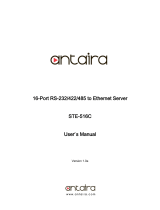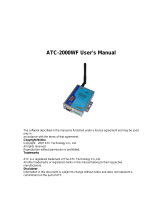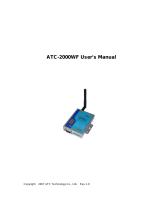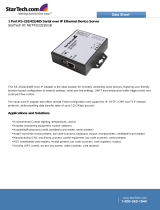Page is loading ...

WiComm-1
User’s Guide
Ver 1.0b
2008. 09. 09

Revision History
Revision Date
Document
Version
Pages Description
Feb, 13, 2007 1.0a All Context amendment by shlee
Sept, 9, 2008 1.0b All Roaming Added by shlee
A-Class Device Product
This device is registered only for office use, and both the seller and the user must be aware of this.
If not correctly sold or purchased, please exchange with home use device.

Table of Contents
I
Table of Contents
Chapter 1. Introduction..............................................................................................1-1
1.1 About This Document................................................................................................ 1-1
1.2 Target Audience ........................................................................................................ 1-1
1.3 Guide Content and Organization............................................................................... 1-2
1.4 WiComm-1 Document............................................................................................... 1-3
1.5 Technical Supports.................................................................................................... 1-3
Chapter 2. Getting Started.........................................................................................2-1
2.1 Overview................................................................................................................... 2-1
2.2 Features.................................................................................................................... 2-1
2.3 Package.................................................................................................................... 2-2
2.4 Applications............................................................................................................... 2-3
Chapter 3. Hardware Description..............................................................................3-1
3.1 WiComm-1................................................................................................................ 3-1
3.1.1 Exterior View................................................................................................................. 3-1
3.1.2 Part Name..................................................................................................................... 3-2
3.2 Connector Specification ............................................................................................ 3-3
3.2.1 DB9 Connector Specification ........................................................................................ 3-3
3.2.2 RJ-45 Ethernet Specification......................................................................................... 3-6
3.2.3 Power Connector........................................................................................................... 3-6
3.2.4 Terminal Block Power Connector.................................................................................. 3-7
3.3 LED Specification...................................................................................................... 3-8
3.4 Reset Button ............................................................................................................. 3-9
3.5 Wireless antenna .................................................................................................... 3-10
Chapter 4. Installation................................................................................................4-1
4.1 Connecting the PC.................................................................................................... 4-1
4.1.1 Connecting the LAN Cable............................................................................................ 4-1
4.1.2 Connecting the Serial Cable ......................................................................................... 4-1
4.1.3 Connecting the power adapter...................................................................................... 4-2
4.2 WiComm-1 Access and Environment Setting ........................................................... 4-2
4.2.1 Network Setting for a PC............................................................................................... 4-2
4.2.2 Environment Setting...................................................................................................... 4-3
4.3 Checking the Operation ............................................................................................ 4-4
4.3.1 Checking Serial Port Operation..................................................................................... 4-4
4.3.2 Checking Wireless LAN Operation................................................................................ 4-6
Chapter 5. Setting via Web........................................................................................5-1
5.1 Accessing the Web ................................................................................................... 5-1
5.2 Setup Menu............................................................................................................... 5-2
5.3 Network Settings....................................................................................................... 5-3

Table of Contents
II
5.4 Serial Settings........................................................................................................... 5-6
5.5 Wireless Settings .................................................................................................... 5-10
5.6 Admin Settings........................................................................................................ 5-14
5.7 Change Password................................................................................................... 5-16
5.8 Update Firmware..................................................................................................... 5-17
5.9 Factory Default........................................................................................................ 5-18
5.10 Save & Reboot........................................................................................................ 5-19
Chapter 6. Setting via Telnet.....................................................................................6-1
6.1 Telnet Connection ..................................................................................................... 6-1
6.2 Setup Commands ..................................................................................................... 6-2
6.3 View Commands....................................................................................................... 6-3
6.4 Network Command ................................................................................................... 6-4
6.4.1 Setting Wireless Network.............................................................................................. 6-4
6.4.2 Setting Ethernet............................................................................................................. 6-4
6.4.3 Setting Management..................................................................................................... 6-5
6.5 Serial Commands...................................................................................................... 6-6
6.6 Wireless Network Commands................................................................................... 6-8
6.6.1 Command List............................................................................................................... 6-8
6.6.2 Setting WEP.................................................................................................................. 6-9
6.7 Management Setting............................................................................................... 6-10
6.8 System Commands................................................................................................. 6-10
Chapter 7. Setting Guide for each Configuration....................................................7-1
7.1 Preparation for the Environment Setting................................................................... 7-1
7.1.1 PC Network Setting....................................................................................................... 7-1
7.1.2 Ping Test........................................................................................................................ 7-2
7.1.3 Access to a Web Server................................................................................................ 7-4
7.2 Connecting to Access Point (Infrastructure Mode).................................................... 7-5
7.2.1 Logging on the WiComm-1 ........................................................................................... 7-6
7.2.2 Network Settings........................................................................................................... 7-7
7.2.3 Serial Settings............................................................................................................... 7-8
7.2.4 Wireless Settings........................................................................................................... 7-9
7.2.5 Save & Reboot............................................................................................................ 7-10
7.2.6 Serial Loopback Test................................................................................................... 7-10
7.3 Connecting in Serial to Serial by Using Two WiComm-1 Systems (Ad-Hoc Mode).7-11
7.3.1 Logging on to the WiComm-1 ..................................................................................... 7-12
7.3.2 Network Settings (Server)........................................................................................... 7-13
7.3.3 Serial Settings (Server)............................................................................................... 7-14
7.3.4 Wireless Settings (Server) .......................................................................................... 7-15
7.3.5 Save & Reboot (Server).............................................................................................. 7-16
7.3.6 Network Settings (Client) ............................................................................................ 7-17
7.3.7 Serial Settings (Client)................................................................................................. 7-18
7.3.8 Wireless Settings (Client)............................................................................................ 7-19

Table of Contents
III
7.3.9 Save & Reboot (Client)................................................................................................ 7-20
7.3.10 Operation Test............................................................................................................. 7-21
7.4 Connecting the WiComm-1 to a Wireless PC LAN (Ad-Hoc Mode)........................ 7-22
7.4.1 Logging on to the WiComm-1 ..................................................................................... 7-23
7.4.2 Network Settings......................................................................................................... 7-24
7.4.3 Serial Settings............................................................................................................. 7-25
7.4.4 Wireless Settings......................................................................................................... 7-26
7.4.5 Save & Reboot............................................................................................................ 7-27
7.4.6 Serial Loopback Test................................................................................................... 7-27
7.5 Security Setting....................................................................................................... 7-28
7.5.1 WEP Mode.................................................................................................................. 7-28
Chapter 8. Appendix..................................................................................................8-1
8.1 Updating Firmware....................................................................................................... 8-1
8.1.1 Firmware Update via TFTP........................................................................................... 8-3
8.2 Troubleshooting......................................................................................................... 8-5
8.2.1 Troubleshooting for Installation..................................................................................... 8-5
8.2.2 Troubleshooting for Setting Networks........................................................................... 8-5
8.2.3 Troubleshooting for Setting Ports.................................................................................. 8-5
8.2.4 Troubleshooting for Setting Wireless Networks ............................................................ 8-6
8.3 Product Specifications............................................................................................... 8-7
8.4 FCC Statement.......................................................................................................... 8-9

Table of Contents
IV
List of Figures
Figure 2-1. WiComm-1’s Package ................................................................................ 2-2
Figure 3-1. WiComm-1 Exterior Dimension................................................................... 3-1
Figure 3-2. WiComm-1 Part Name................................................................................ 3-2
Figure 3-3. DB9 Serial Connector................................................................................. 3-3
Figure 3-4. 3-Pin-Jumper Header.................................................................................. 3-4
Figure 3-5. Terminal Block............................................................................................. 3-7
Figure 3-6. Top’s LED.................................................................................................... 3-8
Figure 3-7. Bottom’s LED.............................................................................................. 3-9
Figure 3-8. Reset Button............................................................................................... 3-9
Figure 3-9. Wireless antenna...................................................................................... 3-10
Figure 4-1. PC Network Setting Window....................................................................... 4-2
Figure 4-2. Serial Setting Window................................................................................. 4-4
Figure 4-3. Test Data Display Window.......................................................................... 4-5
Figure 4-4. Wireless Status Window ............................................................................. 4-6
Figure 5-1. Initial Window for WiComm-1 Connection .................................................. 5-1
Figure 5-2. Initial Login Window.................................................................................... 5-2
Figure 5-3. Network Setting Window............................................................................. 5-3
Figure 5-4. Management Setting Window..................................................................... 5-5
Figure 5-5. Serial Setting Window................................................................................. 5-6
Figure 5-6. Wireless LAN Setting Window.................................................................. 5-10
그림 5-7. Wireless Roaming Setting Windows.............................................................. 5-12
Figure 5-7. WEP Setting Window................................................................................ 5-13
Figure 5-10. Admin Settings Setting Window................................................................ 5-14
Figure 5-11. Change Password Setting Window........................................................... 5-16
Figure 5-12. Update Firmware Setting Window ............................................................ 5-17
Figure 5-13. Factory Default Setting Window................................................................ 5-18
Figure 5-14. Save & Reboot Setting Window................................................................ 5-19
Figure 6-1. Telnet Access.............................................................................................. 6-1
Figure 7-1. Internet Protocol (TCP/IP) Registration Information ................................... 7-1
Figure 7-2. Ping Test..................................................................................................... 7-2
Figure 7-3. Ping Test Result Message .......................................................................... 7-2
Figure 7-4. WiComm-1 Web Server Login Window ...................................................... 7-4
Figure 7-5. Connecting to an Access Point (Infrastructure Mode)................................. 7-5

Table of Contents
V
Figure 7-6. WiComm-1 Summary.................................................................................. 7-6
Figure 7-7. Infrastructure Mode Network Settings......................................................... 7-7
Figure 7-8. Infrastructure Mode Serial Settings............................................................. 7-8
Figure 7-9. Infrastructure Mode Wireless Settings........................................................ 7-9
Figure 7-10. Infrastructure Mode Save & Reboot.......................................................... 7-10
Figure 7-11. Connecting two WiComm-1 Systems (Ad-Hoc Mode)...............................7-11
Figure 7-12. WiComm-1 Summary................................................................................ 7-12
Figure 7-13. Ad-Hoc Mode Network Settings (Server)................................................... 7-13
Figure 7-14. Ad-Hoc Mode Serial Settings (Server)....................................................... 7-14
Figure 7-15. Ad-Hoc Mode Wireless Settings (Server).................................................. 7-15
Figure 7-16. Ad-Hoc Mode Save & Reboot (Server)..................................................... 7-16
Figure 7-17. Ad-Hoc Mode Network Settings(Client).................................................... 7-17
Figure 7-18. Ad-Hoc Mode Serial Settings(Client)......................................................... 7-18
Figure 7-19. Ad-Hoc Mode Wireless Settings (Client).................................................... 7-19
Figure 7-20. Ad-Hoc Mode Save & Reboot(Client)....................................................... 7-20
Figure 7-21. Checking the Access in Ad-Hoc Mode....................................................... 7-21
Figure 7-22. Connecting the WiComm-1 to Wireless PC LAN (Ad-Hoc Mode)............. 7-22
Figure 7-23. WiComm-1 Summary................................................................................ 7-23
Figure 7-24. Ad-Hoc Mode Network Settings................................................................ 7-24
Figure 7-25. Ad-Hoc Mode Serial Settings.................................................................... 7-25
Figure 7-26. Ad-Hoc Mode Wireless Settings................................................................ 7-26
Figure 7-27. Ad-Hoc Mode Save & Reboot................................................................... 7-27
Figure 7-28. WEP Security Setting................................................................................ 7-28
Figure 7-29. WEP 64Bit Key Value Setting ................................................................... 7-29

Table of Contents
VI
List of Tables
Table 1-1. WiComm-1 Related Technical Documents ................................................. 1-3
Table 5-1. Key Functions of the Setup Menu............................................................... 5-2
Table 5-2. Key Functions of Portview Configuration.................................................... 5-3
Table 5-3. Key Functions of Wireless Network Configuration...................................... 5-4
Table 5-4. Key Functions of Ethernet Configuration.................................................... 5-4
Table 5-5. Key Functions of Management Configuration............................................. 5-5
Table 5-6. Key Functions of Portview Configuration.................................................... 5-5
Table 5-7. Key Functions of Serial Settings................................................................. 5-7
Table 5-8. Key Functions of Wireless Settings ...........................................................5-11
Table 5-9. Key Functions of Wireless Roaming......................................................... 5-12
Table 5-9. Key Functions of Wireless Security .......................................................... 5-12
Table 5-10. Key Functions of WEP Authentication ...................................................... 5-13
Table 5-13. Key Functions of Admin Settings.............................................................. 5-15
Table 5-14. Key Functions of Save & Reboot.............................................................. 5-19
Table 6-1. Basic Setup Commands ............................................................................. 6-2
Table 6-2. View Commands......................................................................................... 6-3
Table 6-3. Serial Commands ....................................................................................... 6-6
Table 8-1. Product Specifications................................................................................. 8-7

Chapter1. Introduction
Chapter 1. Introduction
This chapter is an introduction to SystemBase’s wireless device server WiComm-1 and related document.
1.1 About This Document
This guide is designed for users of WiComm-1, who are in charge of connecting to and communicating with
WiComm-1, setting WiComm-1’s configurations, status monitoring, firmware update, and other administration
work.
1.2 Target Audience
This manual is intended for WiComm-1 users and administers. It is strongly recommended to read carefully before
using or setting WiComm-1. This guide contains information on hardware level application and software level
configuration. The understanding of this guide will be a great starting point for any administrators who want to
easily monitor and control WiComm-1 and its connection devices.
1-1

Chapter1. Introduction
1.3 Guide Content and Organization
Chapter1. Introduction is a preface with general information and introductory notices.
Chapter2. Getting Started describes a brief introduction to WiComm-1, including features and applications.
Chapter 3. Hardware Description explains about the product layout and pin specifications with block
diagram and drawings.
Chapter 4. Installation describes how to connect between WiComm-1 serial and network and how to start the
system initially and inspect the system status.
Chapter 5. Setting via Web provides menu-by-menu guide for wetting up WiComm-1 via web browser.
Chapter 6. Setting via Telnet describes the commands required for setting for WiComm-1 via telnet.
Chapter 7. Setting Guide for Each Configuration provides the settings for each configuration, giving
representative examples to use WiComm-1.
Chapter 8. Appendix provides troubleshooting and technical specifications for the product.
1-2

Chapter1. Introduction
1-3
1.4 WiComm-1 Document
The following table summarizes documents included in the WiComm-1 document set.
Table 1-1. WiComm-1 Related Technical Documents
Document Name Description
User Guide
Integration, configuration, and management tasks are explained
for the administrator
Portview User Manual
Guide for SystemBase device server management application
Portview
COM Port Redirector User
Manual
Guide for SystemBase COM Port Redirector
If you need brief information on WiComm-1 or wireless device servers in general, please visit our website at
http://www.sysbas.com/
. You can view and/or download documents related to WiComm-1 as well as latest software
and firmware updates. Available resources are as follows:
Document Name Description
WiComm-1 Spec Sheet Specifications for WiComm-1 products
WiComm-1 White Paper
An easy reading for anyone new to wireless device server.
Deals with background and technology Past, present, and
future of wireless device servers along with the overview of
market environment
WiComm-1 Application
Notes
Usage of WiComm-1 with diagrams and images
Note
All documents are updated promptly, so check for the recent document update. The contents in
these documents are subject to change without any notice in advance.
1.5 Technical Supports
There are three ways you can get a technical support from SystemBase.
First, visit our website http://www.sysbas.com/
and go to ‘Technical Support’ menu. There you can read FAQ and
ask your own question as well.
Second, you can e-mail our technical support team. The mail address is [email protected]
. Any kind of inquiries,
requests, and comments are welcome.
Finally, you can call us at the customer center for immediate support. Our technical support team
will kindly help you get over with the problem. The number to call is 82-2-855-0501

Chapter 2. Getting Started
Chapter 2. Getting Started
This chapter includes WiComm-1 overview, main and distinctive features, package contents for each product, and
application fields.
2.1 Overview
WiComm-1 provides wireless network connectivity to various serial devices (security devices, communication
peripherals, modems, data printing devices, industrial metering devices, etc.). WiComm-1 supports RS232, RS422,
and RS485 serial communication standards under various communication speed, meanwhile connecting to the
IEEE 802.11b/g wireless network and auto-sensing 100baseTX Fast Ethernet and 10baseT Ethernet connection.
2.2 Features
WiComm-1’s basic function as follow:
y Support IEEE 802.11b/g (Max. 54Mbps)
y Support WEP 64 bit / 128 bit
y Serial Communication Speed Max. 921.6kbps
y Software configurable RS232/422/485 interfaces
y 10/100Mbps Ethernet port
y SystemBase COM Port Redirector for better adaptability
y Extensive configuration and monitoring with Portview
y Firmware upload with Web and FTP
y Configuration with Web, Telnet, SNMP, and Portview
y Support SNMP
y Power supply function using RI pin
2-1

Chapter 2. Getting Started
2-2
2.3 Package
WiComm-1 package is composed of following components. All packages include a WiComm-1 and a CD with
utilities and documents. Make sure every component is included with your package.
Figure 2-1. WiComm-1’s Package
Box
WiComm-1
Body
Manual CD
Power Adaptor
Powe
r
Cable
Serial
Cable
A
ntenn
Crossover
LAN Cable

Chapter 2. Getting Started
2-3
2.4 Applications
WiComm-1 can be applied to many practical applications in various fields.
Factory / Industrial Automation
y PLC, Robot arms, Human-Machine Interface, Warehouse rails
y Medical instruments, Inspection equipment controllers, alarming units
Home Appliances / Electronic Devices
y Power controller, Gaming machines
y Scales, Gas detection units, Water & pollution metering devices
y Data collection and distribution units
Financial / Building Automation
y Card readers, Barcode scanners, Kiosks, Point-Of-Sale(POS) related devices
y Serial printers, Cash registers, Credit card authorization terminals
y Biometric detection units, Security devices

Chapter 3. Hardware Description
3-1
Chapter 3. Hardware Description
This chapter provides WiComm-1's hardware block diagram, pin specifications, dimensions and other hardware-
related information.
3.1 WiComm-1
WiComm-1 provides an Ethernet LAN port of the RJ-45 connector and can directly access when wireless network
is not working. In addition, WiComm-1 is, also, a serial port of DB9 connector and a user can select and use a
desired serial interface of RS 232/422/485.
3.1.1 Exterior View
The exterior dimension of WiComm-1 is as follows:
Figure 3-1. WiComm-1 Exterior Dimension
108mm
170mm
45mm
71mm
95mm
25mm

Chapter 3. Hardware Description
3.1.2 Part Name
Figure 3-2. WiComm-1 Part Name
Connector
DB9 Serial
Antenna
Connector Part
Power Adaptor
Connector Part
LAN Port
Terminal Block
Power Connector
Lower LEDs
Reset Button
Upper LEDs
3-2

Chapter 3. Hardware Description
3.2 Connector Specification
3.2.1 DB9 Connector Specification
Pin specifications and signal definition of the DB9 connector are as follows:
1. DB9 Serial Connector
Figure 3-3. DB9 Serial Connector
2. RS232 Signal Specification
Pin Signal Description
1 DCD Data Carrier Detection (Input)
2 RXD Receive Data (Input)
3 TXD Transmit Data (Output)
4 DTR Data Terminal Ready (Output)
5 GND Ground
6 DSR Data Set Ready (input)
7 RTS Request to Send (Output)
8 CTS Clear to Send (Input)
9 RI Ring Indicator (Input)
3-3

Chapter 3. Hardware Description
If opening the cover of the product after unfastening clamp screws, there is 3-pin jumper header in the indicated box
below. Depending on the connection of this jumper pin, this product operates in Vin or RI.
In setting as RI
In setting as Vin
3
2
1
3
2
1
Figure 3-4. 3-Pin-Jumper Header
Mode Setting Description
RI 1-2 connection RI operation
Pin 9 in the DB9 serial connector is used for the input.
Vin 2-3 connection
DC 9 ~ 48 V(6W)
•For 12V DC input: Min. 500mA
•For 48V DC input: Min. 125mA
3-4

Chapter 3. Hardware Description
3. RS422 Full Duplex Signal Specification
Pin Signal Description
2 RXD+ Receive differential data positive (Input)
3 TXD+ Transmit differential data positive (Output)
6 RXD- Receive differential data negative (input)
7 TXD- Transmit differential data negative (Output)
4. RS485 Half Duplex
Pin Signal Description
3 TRX+ Transmit/Receive differential data positive
7 TRX- Transmit/Receive differential data negative
3-5

Chapter 3. Hardware Description
3.2.2 RJ-45 Ethernet Specification
Pin Signal Description
1 TXD+ Transmit Data +
2 TXD- Transmit Data -
3 RXD+ Receive Data +
6 RXD- Receive Data -
LED Description
Left Green
For 100Base-TX Link : LED ON
For data receive/transmit : LED blinks
Right Yellow
For 10Base-T Link : LED ON
For data receive/transmit : LED blinks
3.2.3 Power Connector
+9~48VDC
Ground
Contact Polarity
Center
DC 9 ~ 48 V(6W)
•For 12V DC input: Min. 500mA
•For 48V DC input: Min. 125mA
Outer Ground
3-6
/




